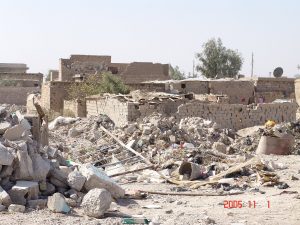
The United States initiated a series of military operations in Fallujah beginning in April 2003, culminating in the Second Battle of Fallujah on December 23, 2004. According to Iraqi NGOs and medical workers, an estimated 4,000 to 6,000 lives were lost during this period. The compensation commissioner of Fallujah reported that 36,000 of the city’s 50,000 homes were destroyed, along with 60 schools and 65 mosques and shrines.
Beyond the immediate devastation of war, the long-term consequences of toxic contamination are now becoming increasingly evident. A research team led by Dr. Aaron Specht and colleagues (2024) conducted systematic environmental sampling across the city and found alarming levels of heavy metal contamination in the soil, particularly uranium, lead, arsenic, and mercury. These toxic substances are believed to be associated with military activity, including the use of depleted uranium munitions.
While U.S. military forces initially denied the use of controversial munitions in Fallujah, they later admitted to having used white phosphorus shells during the battles. Although official statements downplayed the use of depleted uranium, independent environmental studies have since confirmed the presence of uranium and other heavy metals in Fallujah’s soil and in the bodies of residents. This suggests that, regardless of official denials, DU contamination remains.
Further interdisciplinary research, published by Rubaii et al. in the Costs of War project (2025), revealed that 29% of participants had detectable uranium in their bones, while 100% showed lead accumulation—at levels 600% higher than those found in similarly aged populations in the United States. This in vivo bone analysis is groundbreaking, offering the first such evidence of uranium exposure among living civilians in post-conflict zones.
“Our study demonstrates that exposure to remnants of war, amplified by vitamin deficiencies, may play a role in these health outcomes.”
The findings further highlight the relationship between war-related toxic exposure and maternal malnutrition:
“Especially during the first trimester of pregnancy, insufficient folate intake can lead to neural tube defects like spina bifida. This risk is compounded when handling war debris, as certain heavy metals can disrupt folate pathways, intensifying poor birth outcomes.”
Another quote worth noting:
“Uranium has known impacts on neurological function but is the least studied of the metals identified here for birth outcomes.”
These findings contextualize disturbing increases in birth defects and reproductive disorders in Fallujah, already observed by doctors and researchers. As ICBUW expert Jack Cohen-Joppa noted, these abnormalities likely stem not only from DU but also from malnutrition and general toxic load—creating a synergistic public health crisis.
Extensive earlier studies, such as those by Al-Azzawi (2019), have documented how DU aerosols contaminate air, soil, and water across wide areas. Exposure is not limited to soldiers or direct impact zones but affects civilians through inhalation, ingestion, and agricultural pathways.
Similarly, a study by Fathi et al. (2013) warns that DU particles absorbed into plants may enter Iraq’s food chain and bioaccumulate.
“[Heavy metal deposits, like depleted uranium, carve new] pollution pathways that may have serious impacts on the regions’ food chains and subsequently on human health across Iraq.”
The investigations into Fallujah reveal a complex picture in which multiple factors interact: beyond the confirmed use of white phosphorus, depleted uranium and other heavy metals also play a role, with their toxic effects compounded by medical and social burdens such as pregnancy risks, malnutrition, and inadequate healthcare, together driving the devastating health outcomes observed. With similar contamination risks in Gaza, Ukraine, and other warzones, the consequences of modern munitions extend far beyond the battlefield.
The International Coalition to Ban Uranium Weapons (ICBUW) strongly condemns the use of depleted uranium weapons and calls for urgent independent environmental monitoring, rapid clean-up of contaminated areas, and sustained healthcare support for affected communities.
ICBUW – Research and Communications Assistant, 24.08.2025
This article is also available as a PDF download (with references)

